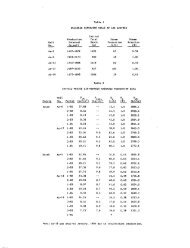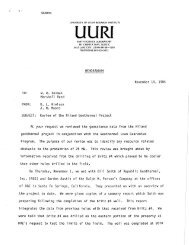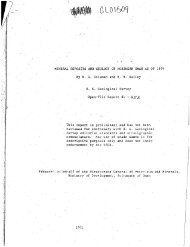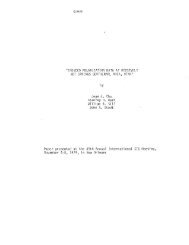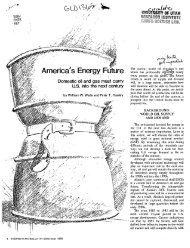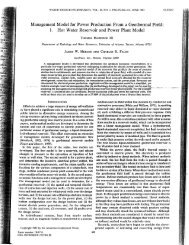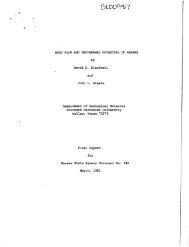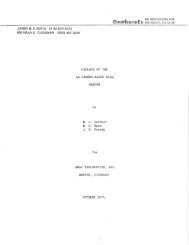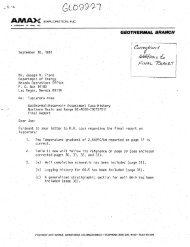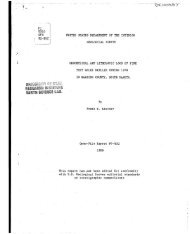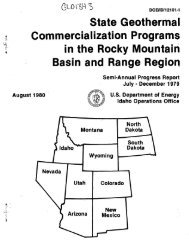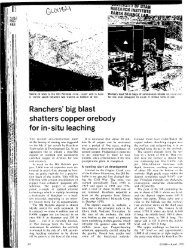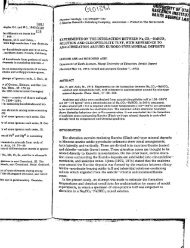Figure I Generalized map of the Wilbur Mining ... - University of Utah
Figure I Generalized map of the Wilbur Mining ... - University of Utah
Figure I Generalized map of the Wilbur Mining ... - University of Utah
Create successful ePaper yourself
Turn your PDF publications into a flip-book with our unique Google optimized e-Paper software.
2. near <strong>the</strong> County MuseLmi well (pr using <strong>the</strong><br />
actual, well); and<br />
3. near <strong>the</strong>-end <strong>of</strong> <strong>the</strong> secondary supply Tine<br />
{near <strong>the</strong>' County Courthouse')'.<br />
Location 1 is best to minimize <strong>the</strong> effect on<br />
adjacent wells in terms <strong>of</strong> water levels,, but may<br />
cause premature temperature breakthrough. Location<br />
2 elimi nates a return pipeTine to <strong>the</strong> production<br />
zone and can use <strong>the</strong> existing museum well.<br />
Temperature .effect would also be less due to lower<br />
well water temperatures'in <strong>the</strong> injection area<br />
(around 180° to l:9d°F). Location 3 could be considered<br />
if .<strong>the</strong> primary heat, exchange facility were<br />
eliminated, thus elirainatirig <strong>the</strong> heed for <strong>the</strong><br />
cTosed-lobp sjecondary p.ipellne. Geo<strong>the</strong>rmal water<br />
would <strong>the</strong>ri be desliyered directly to all buildings,<br />
similar-to <strong>the</strong> Icelandic system. Each building<br />
would <strong>the</strong>n be required 'to supply <strong>the</strong>ir ortn heat exchanger<br />
or use <strong>the</strong> fluid directly. Injection near<br />
<strong>the</strong> end <strong>of</strong> <strong>the</strong> line would eliminate <strong>the</strong> need for a<br />
return linei but may effect cold (60°' to 90°F) water<br />
wells in <strong>the</strong> area,.<br />
LBL reGonmends <strong>the</strong>^ second location, which is<br />
<strong>the</strong> main dfe considered in this report. The drilling<br />
and testing <strong>of</strong> at least two deep wells ih <strong>the</strong><br />
production area is necessary to better jevaluate<br />
this Tecommendatian.<br />
Dri'ltinq Costs - Klamath Basin. Well drilling<br />
costs in <strong>the</strong> Klaraath Basin by cable or r-otary rigs<br />
up to 3,000 feet are as follov/s:<br />
$1,00 per inch <strong>of</strong> diameter-per foot <strong>of</strong> depth<br />
in "s<strong>of</strong>t" rock, and<br />
$2.50 per inch <strong>of</strong> diamelier per foot <strong>of</strong> depth<br />
iri "hard" rock up to 500 feet in defith.<br />
For every additional 100-foot increment, add<br />
41.00 per-foot <strong>of</strong> clepth-<br />
Casing costs can be estimated at $1 ...05 per<br />
inch <strong>of</strong> diameter per foot Of depth. Full^<br />
depth casing is assuraed for all wells.<br />
Using <strong>the</strong>se costs, which include mobilization<br />
arid dempbilization, and assuraing that <strong>the</strong> production<br />
wells encounter <strong>the</strong> tsa'nie amounts <strong>of</strong> "hard" and<br />
"s<strong>of</strong>t" drilling that <strong>the</strong> test well log indicatesi<br />
drilTihg and casing <strong>of</strong> a 1,OdO-ft well would cost<br />
.$38,,'898 with full-depth casing. These costs are<br />
expected to: rise apprpximately 10% in <strong>the</strong> very nearfuture,<br />
and do not include costs for drilling mud,<br />
additional air- compressprs if requiredi -foaraing<br />
ageri'ts, etc.<br />
Central Heat Exchangers<br />
<strong>the</strong>re are three basic'methods <strong>of</strong> transferring<br />
<strong>the</strong> heat fro.m <strong>the</strong> gep<strong>the</strong>rmal water to <strong>the</strong> buildirig<br />
•air space. These are: 1} Use-, <strong>the</strong> geo<strong>the</strong>rmal water<br />
directly iri <strong>the</strong> building heat emitters.; 2} Utilize<br />
individual building hea't exchangers to transfer<br />
heat-frora <strong>the</strong> geo<strong>the</strong>rmal water to a building cTo'sedwater<br />
loop which in turn transfers heat to <strong>the</strong> heat<br />
emitters; arid 3) Utilize large central heat exchanger's<br />
to transfer heat to a di;strict. closed-war<br />
ter loop and supply <strong>the</strong> buildings with fresh-heated<br />
387<br />
Lund, et. al.<br />
water to be used in <strong>the</strong> heat emitters. Each system<br />
has its advantages and disadvantages.<br />
Even though <strong>the</strong> geo<strong>the</strong>rmal water in Klamath<br />
Falls IS relativeiy pure, <strong>the</strong> dire.ct use in heat<br />
emitters Is nol; recommended, especially in <strong>the</strong> fan<br />
coil units <strong>of</strong> air handling systeras and small tube<br />
baseboard units-. Experience with direct use at<br />
OIT, Shadow Hills Apartments, Kingswood .Manor<br />
apartmehts, arid several businesses in <strong>the</strong> East Main<br />
Street .area indicate that life expectancy <strong>of</strong> <strong>the</strong><br />
fan coils may range from 1 1/2 Or 2 years to 12 or<br />
15 years. At both Shadow Hills and Kingswood Manor,<br />
leaks in fan coil units developed in 2.years or<br />
less. Inspection <strong>of</strong> <strong>the</strong> units shows corrosion occurring<br />
in <strong>the</strong> units priraariiy at soldered joints<br />
and: changes in direction <strong>of</strong> <strong>the</strong> tubes at "<strong>the</strong> ends,,<br />
although a few leaks have occurred in <strong>the</strong> main<br />
body <strong>of</strong> units v/here tubes are straight. AtOJT,<br />
five failures have occurred ir <strong>the</strong> 14 years <strong>the</strong><br />
Ltriits have been in service., again with most near<br />
soldered joints, headers^ and at <strong>the</strong> ends df cOils,<br />
There are no known di.rect uses <strong>of</strong> sraalT-finned tube<br />
baseboaird units, bui: since <strong>the</strong> materials and methods<br />
<strong>of</strong> construction are similar, it is assumed<br />
<strong>the</strong>y would have Simflar life tiraes. The exact nature<br />
and cause <strong>of</strong> <strong>the</strong> failures, arid as, importantly<br />
<strong>the</strong> difference in life <strong>of</strong> some units, is not. known<br />
but is undeif study by OIT, Battel Te N-W. and<br />
Radian Corporation iri a joint effort. Until <strong>the</strong><br />
cause <strong>of</strong> <strong>the</strong> failures .can be determined and/br .corrected,<br />
direct use is not considered practical.<br />
The-usual material's <strong>of</strong> construction <strong>of</strong> fan<br />
coils are copper "tubes with pressed aluminum fins.<br />
O<strong>the</strong>r jriatenals which may have' To'nger life are<br />
avai'lable, but reduce <strong>the</strong> heat transfer efficiency<br />
and are more costly. As far as is kriown, all units<br />
presently installed in any <strong>of</strong> <strong>the</strong> air handling<br />
units in <strong>the</strong> buildings to be heated in <strong>the</strong> district<br />
do have copper tubes.<br />
Direct Use. The advantages Of direct use are<br />
that water would.be supplied to <strong>the</strong> buildings at<br />
higher temperatuice since heat would not be' lost in<br />
a heat exchanger and <strong>the</strong> distriet construction<br />
cost y/ould be much less'. The main disacfvantage' is<br />
that iperhaps few customers v^oul'd hook up since <strong>the</strong><br />
reduced, cost <strong>of</strong> heat energy would be <strong>of</strong>fset, or<br />
p'er haps exceeded by, increased costs <strong>of</strong> maintenance.<br />
Since experience is liraited, <strong>the</strong> cause <strong>of</strong><br />
failures is unknown, arid useful lives <strong>of</strong> components<br />
apparently varies considerably even, within individual<br />
systeras; maintenanGe and, replacement costs<br />
ate next to impossible to evaluate., and an economic<br />
comparison be'tween this- system and o<strong>the</strong>r's is<br />
impossible,.<br />
Indi vi dual Bui Tdinq Exchangers. The second<br />
riethod, that <strong>of</strong> .supplying geo<strong>the</strong>rmal water to each<br />
building where heat isr transferred -to a closed loop<br />
within <strong>the</strong> .building, is a viable^ alternative and<br />
<strong>of</strong>fers several advantages but in th'e.overa-TT-, is<br />
more mostly due to <strong>the</strong> economics <strong>of</strong> size.<br />
Each :building would have its small heat exchanger,,<br />
probably a plate type, with <strong>the</strong> associated<br />
valves and controls to control <strong>the</strong> pressure flow.



